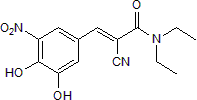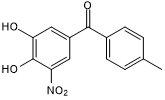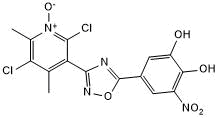Catechol O-Methyltransferase (COMT) Inhibitors Products
COMT (Catechol-O-MethylTransferase) is a 29-30 kDa member of the COMT family of enzymes. It shares the same acronym with plant COMT, or caffeic acid 3-O-methyltransferase that is involved in phenylpropanoid synthesis. Mammalian COMT is widely expressed, and catalyzes the O-methylation of catecholamines, dopamine and estrogen. Human COMT is a 271 amino acid (aa) type II transmembrane (TM) protein. It contains a six aa cytoplasmic N-terminus, an 20 aa TM segment, and a 245 aa luminal/extracellular region that possesses a methyltransferase domain (aa 112-217). This TM form of COMT (termed MB-COMT) is generally associated with pre- and postsynaptic neurons plus glia, and is suggested to be very important in deactivating neurotransmitters, an activity that likely impacts cognition. There is also a 25-26 kDa COMT isoform (termed S-COMT) that utilizes an alternative start site at Met51. This isoform is cytoplasmic and generally found outside the CNS in cells such as mammary and intestinal epithelium, renal tubule epithelium, pancreatic beta-cells, monocytes and mast cells. S-COMT is believed to inactive toxic catechols (hydroxylated benzenes found in plant walls). MB-CORM exhibits high affinity:low capacity activity, while S-COMT shows low affinity:high capacity activity. Two additional alternative start sites have been reported. One starts at Met90, while a second possesses a start site 38 aa upstream of the MB-COMT start site. Over aa 52-271, human COMT shares 79% aa sequence identity with mouse COMT.
4 results for "Catechol O-Methyltransferase (COMT) Inhibitors" in Products
4 results for "Catechol O-Methyltransferase (COMT) Inhibitors" in Products
Catechol O-Methyltransferase (COMT) Inhibitors Products
COMT (Catechol-O-MethylTransferase) is a 29-30 kDa member of the COMT family of enzymes. It shares the same acronym with plant COMT, or caffeic acid 3-O-methyltransferase that is involved in phenylpropanoid synthesis. Mammalian COMT is widely expressed, and catalyzes the O-methylation of catecholamines, dopamine and estrogen. Human COMT is a 271 amino acid (aa) type II transmembrane (TM) protein. It contains a six aa cytoplasmic N-terminus, an 20 aa TM segment, and a 245 aa luminal/extracellular region that possesses a methyltransferase domain (aa 112-217). This TM form of COMT (termed MB-COMT) is generally associated with pre- and postsynaptic neurons plus glia, and is suggested to be very important in deactivating neurotransmitters, an activity that likely impacts cognition. There is also a 25-26 kDa COMT isoform (termed S-COMT) that utilizes an alternative start site at Met51. This isoform is cytoplasmic and generally found outside the CNS in cells such as mammary and intestinal epithelium, renal tubule epithelium, pancreatic beta-cells, monocytes and mast cells. S-COMT is believed to inactive toxic catechols (hydroxylated benzenes found in plant walls). MB-CORM exhibits high affinity:low capacity activity, while S-COMT shows low affinity:high capacity activity. Two additional alternative start sites have been reported. One starts at Met90, while a second possesses a start site 38 aa upstream of the MB-COMT start site. Over aa 52-271, human COMT shares 79% aa sequence identity with mouse COMT.
Potent COMT inhibitor; blocks α-synuclein aggregation
| Chemical Name: | (2E)-2-Cyano-3-(3,4-dihydroxy-5-nitrophenyl)-N,N-diethyl-2-propenamide |
| Purity: | ≥99% (HPLC) |
COMT inhibitor; also inhibits transthyretin aggregation
| Alternate Names: | Tasmar,Ro 40-7592 |
| Chemical Name: | (3,4-Dihydroxy-5-nitrophenyl)(4-methylphenyl)methanone |
| Purity: | ≥99% (HPLC) |
COMT inhibitor
| Chemical Name: | 3,5-Dinitrocatechol |
| Purity: | ≥99% (HPLC) |
COMT inhibitor
| Chemical Name: | 5-[3-(2,5-Dichloro-4,6-dimethyl-1-oxido-3-pyridinyl)-1,2,4-oxadiazol-5-yl]-3-nitro-1,2-benzenediol |
| Purity: | ≥98% (HPLC) |




